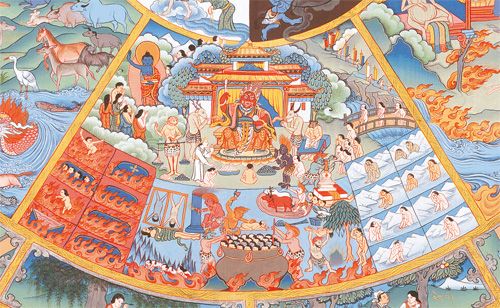Hell beings: Difference between revisions
Jump to navigation
Jump to search
mNo edit summary |
mNo edit summary |
||
| (4 intermediate revisions by 2 users not shown) | |||
| Line 1: | Line 1: | ||
[[Image:Hell_realm.jpg|frame|Depiction of the hell realms from a [[thangka]] of the [[Wheel of Life]]]] | [[Image:Hell_realm.jpg|frame|Depiction of the hell realms from a [[thangka]] of the [[Wheel of Life]]]] | ||
'''Hell beings''' ([[Wyl.]] ''sems can dmyal ba'') — one of the [[six classes of beings]] which inhabit any of the [[Hells|hell realms]]. | '''Hell beings''' (Tib. སེམས་ཅན་དམྱལ་བ་, ''semchen nyalwa'', [[Wyl.]] ''sems can dmyal ba'') — one of the [[six classes of beings]] which inhabit any of the [[Hells|hell realms]]. | ||
[[Khenpo Ngawang Palzang]] describes them in the [[Zindri]]: | [[Khenpo Ngawang Palzang]] describes them in the [[Zindri]]: | ||
| Line 8: | Line 8: | ||
<small><references/></small> | <small><references/></small> | ||
[[Category:Three Realms]] | [[Category:Classes of beings]] | ||
[[Category:Hell Realms]] | |||
[[Category:Three Realms of Samsara]] | |||
Latest revision as of 11:08, 1 December 2021

Hell beings (Tib. སེམས་ཅན་དམྱལ་བ་, semchen nyalwa, Wyl. sems can dmyal ba) — one of the six classes of beings which inhabit any of the hell realms.
Khenpo Ngawang Palzang describes them in the Zindri:
- The bodies of hell beings are four times as big as those of the inhabitants of this world, and the color of boiled blood. Their skin is as delicate as that of a newborn prince, as fragile as gossamer-fine strands of wool. Their bodies are fully fleshed and tender, and exquisitely sensitive to touch, like the eye. Their hair swirls upward, their eyes are triangular, the hairs on their bodies stand on end, and they have big hands and feet and large bellies. The mere sight of these hell beings, like wrathful deities, would be enough to make a person from our world faint.[1]
Notes
- ↑ Khenpo Ngawang Pelzang, A Guide to the Words of My Perfect Teacher, translated by Padmakara Translation Group, Shambhala, 2004, p. 44.